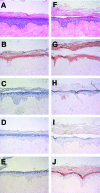Development and validation of human psoriatic skin equivalents
- PMID: 18669614
- PMCID: PMC2527086
- DOI: 10.2353/ajpath.2008.080173
Development and validation of human psoriatic skin equivalents
Abstract
Psoriasis is an inflammatory skin disease driven by aberrant interactions between the epithelium and the immune system. Anti-psoriatic drugs can therefore target either the keratinocytes or the immunocytes. Here we sought to develop an in vitro reconstructed skin model that would display the molecular characteristics of psoriatic epidermis in a controlled manner, allowing the screening of anti-psoriatic drugs and providing a model in which to study the biology of this disease. Human skin equivalents generated from normal human adult keratinocytes after air exposure and stimulation by keratinocyte growth factor and epidermal growth factor displayed the correct morphological and molecular characteristics of normal human epidermis whereas the psoriasis-associated proteins, hBD-2, SKALP/elafin, and CK16, were absent. Skin equivalents generated from foreskin keratinocytes were clearly abnormal both morphologically and with respect to gene expression. When normal skin equivalents derived from adult keratinocytes were stimulated with psoriasis-associated cytokines [tumor necrosis factor-alpha, interleukin (IL)-1alpha, IL-6, and IL-22] or combinations thereof, strong expression of hBD-2, SKALP/elafin, CK16, IL-8, and tumor necrosis factor-alpha was induced as shown by quantitative polymerase chain reaction and immunohistochemistry. Retinoic acid but not cyclosporin A was found to inhibit cytokine-induced gene expression at both the mRNA and protein levels. These results illustrate the potential of this disease model to study the molecular pathology and pharmacological intervention in vitro.
Figures









References
-
- Bowcock AM, Krueger JG. Getting under the skin: the immunogenetics of psoriasis. Nat Rev Immunol. 2005;5:699–711. - PubMed
-
- Schön MP, Boehncke WH. Psoriasis. N Engl J Med. 2005;352:1899–1912. - PubMed
-
- de Jongh GJ, Zeeuwen PL, Kucharekova M, Pfundt R, van der Valk PG, Blokx W, Dogan A, Hiemstra PS, van de Kerkhof PC, Schalkwijk J. High expression levels of keratinocyte antimicrobial proteins in psoriasis compared with atopic dermatitis. J Invest Dermatol. 2005;125:1163–1173. - PubMed
Publication types
MeSH terms
Substances
LinkOut - more resources
Full Text Sources
Other Literature Sources
Medical
Research Materials

